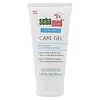What's inside
What's inside
 Key Ingredients
Key Ingredients

 Benefits
Benefits

 Concerns
Concerns

 Ingredients Side-by-side
Ingredients Side-by-side

Water
Skin ConditioningCoco-Caprylate/Caprate
EmollientEthylhexyl Stearate
EmollientGlycerin
HumectantButylene Glycol
HumectantPolyglyceryl-6 Distearate
EmulsifyingCetyl Alcohol
EmollientSclerotium Gum
Emulsion StabilisingHydroxyacetophenone
AntioxidantSodium Stearoyl Glutamate
CleansingJojoba Esters
EmollientCitric Acid
Buffering1,2-Hexanediol
Skin ConditioningCaprylyl Glycol
EmollientPolyglyceryl-3 Beeswax
EmulsifyingButyrospermum Parkii Butter
Skin ConditioningCera Alba
EmollientBoerhavia Diffusa Root Extract
Skin ProtectingHydrolyzed Soy Protein
HumectantCaprylic/Capric Triglyceride
MaskingAloe Barbadensis Leaf Extract
EmollientGorgonia Extract
Skin ConditioningWater, Coco-Caprylate/Caprate, Ethylhexyl Stearate, Glycerin, Butylene Glycol, Polyglyceryl-6 Distearate, Cetyl Alcohol, Sclerotium Gum, Hydroxyacetophenone, Sodium Stearoyl Glutamate, Jojoba Esters, Citric Acid, 1,2-Hexanediol, Caprylyl Glycol, Polyglyceryl-3 Beeswax, Butyrospermum Parkii Butter, Cera Alba, Boerhavia Diffusa Root Extract, Hydrolyzed Soy Protein, Caprylic/Capric Triglyceride, Aloe Barbadensis Leaf Extract, Gorgonia Extract
 Reviews
Reviews

Ingredients Explained
These ingredients are found in both products.
Ingredients higher up in an ingredient list are typically present in a larger amount.
Citric Acid is an alpha hydroxy acid (AHA) naturally found in citrus fruits like oranges, lemons, and limes.
Like other AHAs, citric acid can exfoliate skin by breaking down the bonds that hold dead skin cells together. This helps reveal smoother and brighter skin underneath.
However, this exfoliating effect only happens at high concentrations (20%) which can be hard to find in cosmetic products.
Due to this, citric acid is usually included in small amounts as a pH adjuster. This helps keep products slightly more acidic and compatible with skin's natural pH.
In skincare formulas, citric acid can:
While it can provide some skin benefits, research shows lactic acid and glycolic acid are generally more effective and less irritating exfoliants.
Most citric acid used in skincare today is made by fermenting sugars (usually from molasses). This synthetic version is identical to the natural citrus form but easier to stabilize and use in formulations.
Read more about some other popular AHA's here:
Learn more about Citric AcidGlycerin is already naturally found in your skin. It helps moisturize and protect your skin.
A study from 2016 found glycerin to be more effective as a humectant than AHAs and hyaluronic acid.
As a humectant, it helps the skin stay hydrated by pulling moisture to your skin. The low molecular weight of glycerin allows it to pull moisture into the deeper layers of your skin.
Hydrated skin improves your skin barrier; Your skin barrier helps protect against irritants and bacteria.
Glycerin has also been found to have antimicrobial and antiviral properties. Due to these properties, glycerin is often used in wound and burn treatments.
In cosmetics, glycerin is usually derived from plants such as soybean or palm. However, it can also be sourced from animals, such as tallow or animal fat.
This ingredient is organic, colorless, odorless, and non-toxic.
Glycerin is the name for this ingredient in American English. British English uses Glycerol/Glycerine.
Learn more about GlycerinWater. It's the most common cosmetic ingredient of all. You'll usually see it at the top of ingredient lists, meaning that it makes up the largest part of the product.
So why is it so popular? Water most often acts as a solvent - this means that it helps dissolve other ingredients into the formulation.
You'll also recognize water as that liquid we all need to stay alive. If you see this, drink a glass of water. Stay hydrated!
Learn more about Water